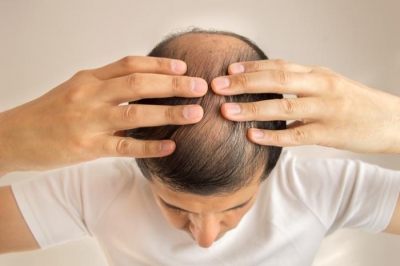
More than 90 per cent of men succumb to some degree of baldness. And some women, particularly after the menopause, also find that their hair thins and recedes. The problem is entirely genetic – bald fathers have sons who are likely to become bald. And it doesn’t just affect humans either: monkeys become bald as well.
The exact genetic code that causes baldness and thinning still eludes researchers, but they know it has something to do with male sex hormones called androgens. These hormones suppress the activity of certain hair follicles on the scalp, so that the life span of their hair that grows from them is reduced. Normally, a hair allowed to grow uncut will last from two or six years. But as baldness sets in, the hair in some areas of the head falls out more often. The overall effect is that the hair in those places gets thinner and shorter, until it is reduced to fuzz.
Men have more androgen than women, which is why more men that women suffer from baldness.
One solution is baldness is a ‘scalp transplant’, which is carried out by a cosmetic surgeon. But only some people are suitable. Their baldness should be stable, that is, not getting worse each year, and should occur mainly at the front and top of the scalp. The remaining hair needs to be dark to hide the effects of the surgery. It also needs to be healthy and abundant because it is this hair that will be transplanted. In hair transplant surgery there are no donors, the patient’s existing hair is simply redistributed.
First the patient’s hair is trimmed closely. Then, usually under local anesthetic, circular sections of scalp are removed from the side or back of the head. These sections are 5/32in (4mm) in diameter and contain from 12 to 18 hair roots. Each section is removed with a hole punch device, from as wide an area of hairy scalp as possible, so that the gaps that are created will be covered by existing hair. The sections are then punched into the bald area of the head using the same instrument.
The number of circular sections required varies, depending on the baldness. In the worst cases, more than 250 are needed.
The time taken for the operation depends on how much hair is being transplanted. Usually, several sessions are necessary, because only up to 20 grafts are made at a time. This process takes from one to one and a half hours.
The holes left where the scalp has been removed take about two weeks to heal, and shrink in the process. overlying hair soon disguises them.
The sections of implanted scalp lose their hair after the operation and it does not start regrowing for about three to six months. It can take a further yer or so before the bald area is covered with hair. In time, however, the transplanted follicles may also be affected by androgen, so the transplant is not necessarily permanent.
Picture Credit : Google




